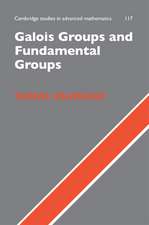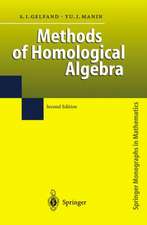Semidistributive Modules and Rings: Mathematics and Its Applications, cartea 449
Autor A.A. Tuganbaeven Limba Engleză Paperback – 15 oct 2012
Din seria Mathematics and Its Applications
- 18%
 Preț: 945.62 lei
Preț: 945.62 lei - 15%
 Preț: 648.42 lei
Preț: 648.42 lei - 15%
 Preț: 651.99 lei
Preț: 651.99 lei - 15%
 Preț: 591.61 lei
Preț: 591.61 lei -
 Preț: 394.29 lei
Preț: 394.29 lei - 18%
 Preț: 955.56 lei
Preț: 955.56 lei - 15%
 Preț: 586.85 lei
Preț: 586.85 lei - 5%
 Preț: 655.17 lei
Preț: 655.17 lei - 15%
 Preț: 658.70 lei
Preț: 658.70 lei - 15%
 Preț: 648.56 lei
Preț: 648.56 lei - 15%
 Preț: 604.84 lei
Preț: 604.84 lei -
 Preț: 394.87 lei
Preț: 394.87 lei - 15%
 Preț: 651.84 lei
Preț: 651.84 lei -
 Preț: 374.76 lei
Preț: 374.76 lei -
 Preț: 394.51 lei
Preț: 394.51 lei - 15%
 Preț: 706.30 lei
Preț: 706.30 lei -
 Preț: 391.02 lei
Preț: 391.02 lei -
 Preț: 389.70 lei
Preț: 389.70 lei - 15%
 Preț: 585.04 lei
Preț: 585.04 lei - 15%
 Preț: 653.98 lei
Preț: 653.98 lei - 15%
 Preț: 587.02 lei
Preț: 587.02 lei - 20%
 Preț: 577.42 lei
Preț: 577.42 lei -
 Preț: 395.47 lei
Preț: 395.47 lei - 15%
 Preț: 601.88 lei
Preț: 601.88 lei - 15%
 Preț: 594.53 lei
Preț: 594.53 lei - 15%
 Preț: 651.84 lei
Preț: 651.84 lei - 15%
 Preț: 649.06 lei
Preț: 649.06 lei -
 Preț: 392.21 lei
Preț: 392.21 lei - 15%
 Preț: 649.06 lei
Preț: 649.06 lei - 15%
 Preț: 643.48 lei
Preț: 643.48 lei -
 Preț: 398.15 lei
Preț: 398.15 lei
Preț: 392.60 lei
Nou
Puncte Express: 589
Preț estimativ în valută:
75.13€ • 78.80$ • 62.54£
75.13€ • 78.80$ • 62.54£
Carte tipărită la comandă
Livrare economică 01-15 aprilie
Preluare comenzi: 021 569.72.76
Specificații
ISBN-13: 9789401061360
ISBN-10: 940106136X
Pagini: 372
Ilustrații: X, 357 p.
Dimensiuni: 160 x 240 x 20 mm
Greutate: 0.52 kg
Ediția:Softcover reprint of the original 1st ed. 1998
Editura: SPRINGER NETHERLANDS
Colecția Springer
Seria Mathematics and Its Applications
Locul publicării:Dordrecht, Netherlands
ISBN-10: 940106136X
Pagini: 372
Ilustrații: X, 357 p.
Dimensiuni: 160 x 240 x 20 mm
Greutate: 0.52 kg
Ediția:Softcover reprint of the original 1st ed. 1998
Editura: SPRINGER NETHERLANDS
Colecția Springer
Seria Mathematics and Its Applications
Locul publicării:Dordrecht, Netherlands
Public țintă
ResearchCuprins
1 Radicals, local and semisimple modules.- 1.1 Maximal submodules and the Jacobson radical.- 1.2 Local and uniserial modules.- 1.3 Semisimple and Artinian modules.- 1.4 The prime radical.- 2 Projective and injective modules.- 2.1 Free and projective modules.- 2.2 Injective modules.- 2.3 Injective hull.- 3 Bezout and regular modules.- 3.1 Regular modules.- 3.2 Unit-regular rings.- 3.3 Semilocal rings and distributivity.- 3.4 Strongly regular rings.- 3.5 Bezout rings.- 4 Continuous and finite-dimensional modules.- 4.1 Closed submodules.- 4.2 Continuous modules.- 4.3 Finile-dimensional modules.- 4.4 Nonsingular ?-injective modules.- 5 Rings of quotients.- 5.1 Ore sets.- 5.2 Denominator sets and localizable rings.- 5.3 Maximal rings of quotients.- 6 Flat modules and semiperfect rings.- 6.1 Characterizations of flat modules.- 6.2 Submodules of flat modules.- 6.3 Semiperfect and perfect rings.- 7 Semihereditary and invariant rings.- 7.1 Coherent and reduced rings.- 7.2 Invariant rings.- 7.3 Rings with integrally closed factor rings.- 8 Endomorphism rings.- 8.1 Modules over endomorphism rings and quasi injective modules.- 8.2 Nilpotent endomorphisms.- 8.3 Strongly indecomposable modules.- 9 Distributive rings with maximum conditions.- 9.1 Arithmetics of ideals.- 9.2 Noel.herian rings.- 9.3 Classical rings of quotients of distributive rings.- 9.4 Rings algebraic over their centre.- 10 Self-injective and skew-injective rings.- 10.1 Quasi-frobenius rings and direct sums of injective modules.- 10.2 Cyclic ?-injective modules.- 10.3 Integrally closed Noetherian rings.- 10.4 Cyclic skew-injective modules.- 10.5 Countably injective rings.- 11 Semidistributive and serial rings.- 11.1 Semidistributive modules.- 11.2 Semidistributive rings.- 11.3 Serial modules and rings.- 12 Monoidrings and related topics.- 12.1 Series and polynomial rings.- 12.2 Quaternion algebras.- 12.3 Subgroups, submonoids, and annihilators.- 12.4 Regular group rings.- 12.5 Cancellative monoids.- 12.6 Semilattices and regular monoids.
Notă biografică
Askar Tuganbaev received his Ph.D. at the Moscow State University in 1978 and has been a professor at Moscow Power Engineering Institute (Technological University) since 1978. He is the author of three other monographs on ring theory and has written numerous articles on ring theory.

















